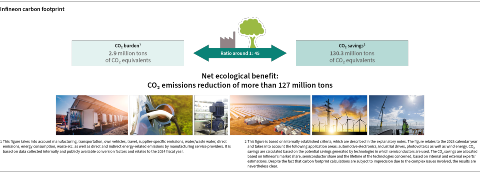Product-related Environmental Sustainability
The keys to greater sustainability and solving climate-related challenges are new technologies that achieve more using fewer resources and save emissions at the same time. “Making more out of less” is the approach Infineon is taking to help develop better solutions for existing problems and play an active role in shaping a worthwhile future.
Since fiscal year, reporting on the EU Taxonomy forms part of our Sustainability Report for the first time. This means that we are complying with the latest regulatory requirements. However, our motivation goes far beyond that. An essential part of our extensive communications is to show how Infineon creates value and how it helps solve the problems of our time – in particular, climate change. The parameters reported in the Taxonomy confirm our strategy and underline the contribution made by our products and solutions to tackle climate change.
Life cycle assessment
At Infineon, we take the responsibility for minimizing the products´environmental and health and safety impact throughout all stages of the products´ life cycle including their use phase. A life-cycle assessment is the first stage to identify environmental impacts in all stages of a product´s life. By integrating sustainable practices from the selection of raw materials, manufacturing process, and storage and distribution to products´ use and end life phase, we provide a responsible service to our customers and product end users.
Please check the Infineon Life Cycle Assessment for more details.
Ecologically positive carbon footprint
During their use-phase, Infineon products enable CO2 emission savings of around 130 million tons of CO2 equivalents.
Semiconductors from Infineon help generate electricity from renewable energy sources. They also offer increased efficiency at all stages of the value chain in the energy sector: in generation, transmission and in particular in the use of electricity. They form a basis for the intelligent and efficient use of energy: in industrial applications, power supplies for computers and consumer electronics as well as in motor vehicles. Semiconductors and solutions from Infineon make end products more energy-efficient during their lifetime and thus make an essential contribution to improving the environmental footprint.
This shows very clearly that Infineon activities are ecologically sustainable.
Furthermore, Infineon also provides products that support digitalization very strongly.
Sustainable handling of hazardous substances
A wide variety of chemicals is required in the manufacturing of semiconductors, some of which are hazardous substances. At Infineon, we responsibly manage the handling of hazardous substances to safeguard human health and environmental protection.
As part of Infineon IMPRES policy, we are moving towards supply chain responsibility, focusing on the purchase of new environmentally friendly materials in the manufacture of its products.
Complying with all currently applicable statutory regulations is self-evident for us.
The European chemicals regulation REACH (Registration, Evaluation, Authorization and Restriction of Chemicals, regulation (EC) No 1907/2006) provides a key regulatory framework for the registration, evaluation, authorisation and restriction of chemical substances on the European market and therefore exerts considerable influence on the procurement and usage of chemicals. As compliance with REACH requirements is indispensable within our supply chain for ensuring reliable delivery, these requirements have been fully integrated in Infineon’s procurement processes.
All Infineon products fulfill the criteria for articles in accordance with the REACH regulation. For this reason, we are not required to register the substances contained in our products.
More information in our REACH Statement
Furthermore, the CLP regulation (EC) No 1272/2008 (Classification, Labeling and Packaging) has great significance for the handling of chemicals. This regulation sets out the classification, labeling and packaging of materials and mixtures and replaces the previously applicable classification and labeling system contained in the directives 67/548/EEC and 1999/45/EC.
The European directives 2000/53/EC governing end-of-life vehicles (ELV Directive: End-of-Life Vehicles) and 2015/863/EU amending Annex II to Directive 2011/65/EU to restrict the use of certain hazardous substances in electrical and electronic devices (RoHS Directive) regulate the use of certain substances classified by legislators as hazardous in the end products.
Infineon’s products comply with these requirements and are conform to the material restrictions in all applicable statutory regulations, including those applicable in countries outside Europe.
For detailed RoHS information for specific products please ask your sales contact.
For more information related to China RoHS click here.
Infineon is the leader of DA5 consortium (Die Attach 5). This is a consortium of companies that jointly investigates lead free alternatives for lead in high temperature solder for attaching die's to leadframes. This is an effort of the semiconductor industry to eliminate lead in high temperature solder, where feasible.
By jointly developing and qualifying an alternative, the DA5 consortium aims to provide lead-free and environmentally friendly solutions as quickly as possible. Read more.
Have a look in our Sustainability Report page 37-39
Documents
-
REACH Declaration
Share Jan 20, 2025 | PDF | 142 kb
-
DA 5 Project Presentation
Share Aug 02, 2024 | PDF | 1.29 mb

